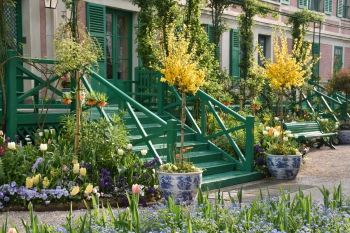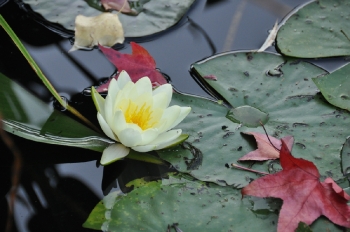Today at Giverny, at the entrance to Monet’s house, two forsythias grown in planters glow for the show.
Forsythia For Ever
April 5, 2017
Flowered Letters
October 4, 2015
At Giverny in Rue Claude Monet, one of the mail boxes to send letters and postcards is located amid flowers.
In October, the helianthus are big enough to reach the height of the mail box.
Their yellow hues match the official color of La Poste boxes.
Having to make your way through the flowers to post your mail makes paying the bills just a little more fun.
Tricyrtis
November 17, 2013
[singlepic id=246 w=320 h=240 float=left]
The common name of this beautiful flower that grows in Monet’s water garden is a bit strange: it’s called toad lily.
The appearance of this perennial is more orchid like.
It requires a moist soil, as do toads, part shade under trees, and in these conditions it is very hardy.
The tricyrtis appears late in season.
This picture was taken in October.
Autumn Nymphea
October 11, 2011
Late Season
October 6, 2009
[singlepic=132,350,350,,right]
The beginning of Autumn is a gorgeous season in Giverny.
Walking in the paths of Monet’s garden provides a unique experience of being merged in the flowers. Giant dahlias, cosmos, sunflowers have reached an incredible height.
All mixed together in enormous bunches of colors, they dance in the slightest breeze.
Overwhelming beauty.
The few visitors exclaim, astonished: It was worth coming! So many flowers! I wouldn’t have believed!
The air smells of sages, lavenders, and the acid fragrance of dying poplar leaves.
The waterlilies floating on the pond seem to be dreaming all day long. They hardly open for a few hours in the afternoon before closing again and returning to their sleep.
Nasturtiums
August 28, 2008
[singlepic=91,350,350,,left]
The main alley of Monet’s garden at Giverny is invaded by nasturtiums.
Monet planted them this way, but originally, it was not on purpose.
Monet wanted to soften the straight lines of his alley by an edge of small flowers, and he planted what he thought were dwarf nasturtiums. Which appeared to be… rambling ones, and they started to creep over the gravel.
Monet liked this effect, then he repeated it intentionally every year.
It is a talent to know how to use one’s own mistakes.
Poppy
June 9, 2008
[singlepic=18,350,350,,right]
Claude Monet liked poppies, red poppies in the fields and pink poppies in his garden at Giverny.
His painting of his wife and son walking in a meadow full of poppies is one of the most famous of musée d’Orsay in Paris.
All the poppies are currently in bloom in his flower garden at Giverny, tiny or enormous, scarlet or pink, orange, yellow, some one color, some two. The pink and purple poppies are spectacular.
Monet preferred one color flowers but he also used two color flowers just as he could take two colors with his brush on his palette and put them in one gesture on the canvas.
Simple Rose
June 2, 2008
[singlepic=17,350,350,,left]
Claude Monet preferred simple roses, with one row of petals instead of more complicated double roses.
Double flowers with many petals seemed too sophisticated for his garden located 80 km from Paris in the small village of Giverny, in the middle of the countryside.
Simple roses look like the wild ones which are currently in bloom in the fields.
In the same range of ideas Monet didn’t consider all the wild flowers like weed. He accepted many of them among the cultivated ones. They give sort of a countryside touch to his flower garden.
Blooming Wisteria
May 14, 2008
[singlepic=87,350,350,,right]
The wisteria is at its peak over the Japanese Bridge in Claude Monet’s garden.
Its flowers look like long grapes. They are a soft tone of lavender and produce a delicious scent which recalls to the scent of jasmine.
It is an incredible feeling to stand on the bridge and be surrounded by the blooming wisteria all around you.
The beautiful effect doesn’t last very long, but Monet had thought of a special jocker. A second later wisteria will follow the lavender one when it is over. The second one is a white wisteria.
Japanese Garden
May 7, 2008
[singlepic=86,350,350,,right]
This part of Monet’s water garden at Giverny ‘looks like Japan’, as the painter would have said.
Monet was inspired by his large collection of Japanese woodblocks when he landscaped his water garden. He planted many exotic species of plants he could see on the prints, like azaleas, rhododendrums, wisterias, bamboos, Japanese maples and of course water lilies. Monet imported peonies in trees from Japan. Many plants in his garden had never been seen before in Giverny.
However his garden is not a true Japanese garden, the spirit being very different.


